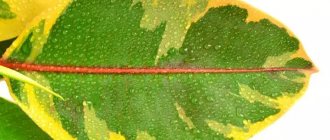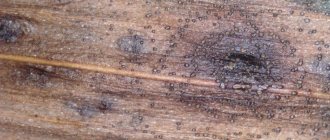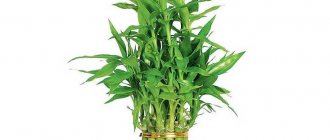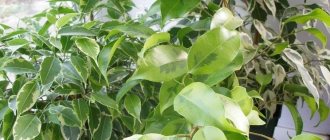Causes of yellowing and falling leaves of balsam
What to do if the leaves of Vanka’s wet balsam turn yellow and fall off?
Let's figure out what are the most common mistakes people make when caring for this flower. So, why can the leaves of a wet Rolyflower turn yellow:
- Direct sunlight.
- Not enough light.
- Little watering.
- Low room temperature.
- Various pests.
- Dried leaves were not cut off in time.
- The leaves were not sprayed.
- In a cold room, you cannot constantly keep the soil wet.
- The plant is not adapted to proximity to other flowers.
- There is dry air above a hot radiator.
- Tobacco smoke.
As follows from the above, when maintaining any plant, balsam is no exception; it is necessary to create certain conditions in which this particular specimen will be comfortable.
What conditions does a flower need to create:
- It is necessary to provide the wet robe with sunlight, but not place it in direct sunlight.
- The flower loves moisture, but in winter it needs to be sprayed more and watered less.
- The temperature should not be too low, below 17ºC, (in winter it can be temporarily 13ºC) and should not exceed 30ºC. The most comfortable temperature for this plant is 21-25 ºC.
- The plant prefers moist air.
- Fertilize with mineral compounds (potassium-phosphorus and nitrogen fertilizers).
- Replant a flower - on average once every 5 years, even more often if possible.
- The flower must, if necessary, be carefully trimmed to form a bush. We are talking about old yellowed leaves and faded peduncles, if you do not need seeds.
- The flower should not be placed on a windowsill in direct sunlight; diffused light or partial shade will do.
- The soil needs to be loose and nutritious.
The best soil mixture for a flower is turf soil, which contains sand and humus. In summer, the plant must be watered daily and a lot, and in winter, moderate watering is indicated. In the summer, sometimes the flower is planted in open ground.
How to help a plant
What to do if all the balsam leaves turn yellow and fall off? First of all, you need to eliminate all errors associated with violations of growing rules. Increase the air humidity level, move the pot to a window with diffused light and organize proper watering. You also need to remember to regularly fertilize the soil. To prevent the appearance of pests and diseases, balsam should be inspected regularly.
Anyone, even a very experienced gardener, can experience yellowing of foliage. There can be many reasons for this problem. The main thing is to detect and eliminate it in time.
Sources:
https://dacha.expert/domashnie-rasteniya/tsvetushhie/balzamin/bolezni-b/zhelteyut-listya-ub.html https://dachamechty.ru/tsvety/vanka-mokryj-listya-zhelteyut-i-opadayut.html https://greensotka.ru/dekorativno-listvennye/pochemu-zhelteyut-listya-u-balzamina.html
Pests, diseases and adverse conditions
Watering balsam must be approached with all responsibility, so that there is enough moisture, but not excessive, especially in winter. You need to water moderately, but regularly spray the leaves to prevent the spread of the fungus. With excess moisture, the soil begins to rot, creating the necessary conditions for the appearance of fungus. In this case, you need to transplant it into another pot as soon as possible, with new soil and plenty of drainage. If the plant is severely damaged, it is better to take cuttings and grow a new healthy plant.
The scale insect is extremely dangerous for balsam. If you find “tubercles” of scale insects, you need to remove them mechanically. And then treat the plant with an alcohol or soap solution, perhaps using a soap-kerosene emulsion. If the lesions are significant, then the following chemicals can be used: Aktara, Actellik or Bankol.
Spider mites are also dangerous. Very often the cause of the appearance is excessively dry air or proximity to diseased plants. The mite may be seen on the leaves in the form of thin cobwebs. The parasite can be destroyed using the previously mentioned drugs plus Neoron or Agravertin.
If the leaves turn yellow and fall off, this is a sign of the appearance of whitefly - a tiny white fly. It should be noted that it is not the adults who harm the flower, but their larvae, similar to aphids. Turning over the leaves of an infected balsam, on the back of the leaf you can see many small insects secreting sweet juice, as a result, the leaves appear sticky. In pest control, the same drugs work effectively as in the case of scale insects and mites, plus Fitoverm. Among the folk remedies, a soap solution made from laundry soap, a solution from dishwashing detergent, and onion tincture have proven themselves to be effective.
Vanka wet diseases treatment: balsam diseases - spider mites, white plaque
Almost every housewife grows balsam. You need to know what diseases Vanya is susceptible to and what treatment is needed if you want to see a constantly blooming and elegant plant. If the basic rules of caring for a flower are not followed, it may die due to attack by pests or the development of diseases.
Causes leading to balsam diseases
The home flower balsam is a moisture-loving plant. The stems and leaves are half made of water, so Vanka wet needs high air humidity and moist soil. Water is not only a source of life for plants and people, but also for pathogenic bacteria and pests.
It is recommended to water the flowerpot with clean and warm water. The pot in which the flower grows must have a drainage hole and a drainage layer. The earth mixture should be loose, moisture- and breathable. To disinfect the soil, it is recommended to add charcoal to it. This substance will prevent the appearance of putrefactive bacteria and fungi.
If you properly care for the plant, it will grow strong, and diseases and pests can be easily destroyed with special means.
Impatiens diseases
If the leaves of the impatiens begin to fall off, and the buds disappear without opening, the following situations may be the reasons for this condition:
- perhaps the flower is simply undergoing adaptation to a new place after purchase. The adaptation period can last for a month. It is important to properly care for balsam: water it, feed it, spray it in a timely manner. Proper care will help the plant acquire beautiful stems and new leaves;
- leaves may fall off due to dry soil. The earthen mixture cracks and lags behind the edges of the pot. Dry soil leads to yellowing, drying, and curling of leaves. It is recommended to water the flower once every seven days;
- Balsam leaves fall off when the soil is too moist. This is evidenced by the moist layer of soil on the second day after watering. If the plant does not have time to dry the soil in a week, it should be transplanted into a container of smaller diameter;
- if the leaves of the plant are covered with a white coating, and they gradually begin to wither and fall off, it means that the balsam has suffered from an attack by a spider mite. It is necessary to take all measures to remove it;
- if the balsam leaves wither only on one side, the watering procedure should be normalized, since the soil is too moist.
Wet Vanka leaves may wilt and become covered with round brown spots due to the soil being too wet. It is recommended to water the flower moderately by adding Fitosporin-M to the water.
The appearance of gray rot
Brown spots appear on the leaves and stems of balsam. This fungal disease is called gray rot. If you do not help the plant in time, it will disappear.
Pathogenic bacteria enter the flower along with water or contaminated soil. The disease can occur due to hypothermia or freezing of the roots of the flower. Drafts, cold water, low air temperature in the room can also lead to the appearance and proliferation of rot.
Gray rot must be removed immediately at the first symptoms of its manifestation. Cut off the affected parts of the flower, and transplant healthy parts into a new pot. You can spray the plant with garlic infusion or foundation.
Development of bacteriosis
Watery spots can be seen on balsam, which indicate the development of bacteriosis. With this disease, the spots quickly increase in size, become brown in color, and soon lead to the death of the flower.
Impatiens can become infected with bacteriosis through contaminated soil, dirty tools or dirty hands. The disease often occurs due to excess moisture, as well as fertilizers in the soil, and polluted air.
If damaged leaves are found, they must be removed immediately to save healthy parts of the plant. The flower is additionally sprayed with a preparation that contains copper.
The appearance of powdery mildew
Balsam leaves may become covered with a white coating, which is caused by powdery mildew. Diseased foliage should be urgently destroyed, and healthy foliage should be treated with soda ash diluted in a liter of water or a copper-soap solution.
If powdery mildew occurs frequently on balsams, you need to change the rules for caring for them. It is recommended to frequently ventilate the room, properly water and feed the flower, and grow it in a well-lit and warm room.
Pests that attack balsam and ways to combat them
Wet Roly often suffers from attacks by thrips, aphids, whiteflies, spider mites and other pests. In each case, their own methods of controlling insects are used, which allow saving the life of the plant.
The leaves of indoor balsam turn yellow: why does this happen and how to help it?
In practice, absolutely any gardener can encounter yellowing of balsam leaves. This problem may have completely different reasons. For example, the cause of yellowing may be improper watering, or various pests.
Many people cannot distinguish between yellowing of leaves due to improper care and natural shedding of leaves. Therefore, below we will tell you how to determine why balsam leaves turn yellow and fall off, what to do and how to treat them, as well as methods of control and prevention.
Problems
In some cases, the process of yellowing of the foliage of “Vanka mokrogo” may be associated with the natural renewal of the vegetative part of the plant. In this case, the phenomenon is focal in nature and quickly stops on its own. If the balsam begins to turn yellow rapidly and profusely, you should start looking for the source of the problem.
Difficulties may arise when growing balsam. We recommend that you familiarize yourself with the following materials to help solve the most common problems:
- Why doesn’t indoor balsam bloom and what to do? Tips for care and cultivation.
- Why do balsam buds and flowers fall off and how to stop it? Prevention measures.
Description of the plant
First, let's tell you what this plant is. Impatiens is a member of the family of annual or perennial herbaceous plants of the Balsamaceae family, although some species of this plant may be subshrubs. Balsam comes from the subtropics and tropics of Africa and Asia , and certain species can also be found in Central Asia.
Since its introduction to Europe in 1596, it has been the most popular indoor plant. The plant itself has long, erect stems reaching a length of up to 50 cm and is a long-flowering plant. The stems are smooth and branched.
The leaves can be lanceolate or oval in shape, and also reach a length of 8-12 centimeters. The color of the petals in nature is red and pink, while hybrids have all colors except yellow and blue.
Reasons why indoor balsam does not bloom
Impatiens is a perennial or annual herbaceous crop of the genus Impatiens (Balsam family), which consists of about five hundred species. Impatiens translated from Latin means “not tolerant.”
Due to the fact that at the slightest touch of the seed pods, they burst and scatter their seeds at a fairly large distance from the main flower, balsams are commonly called Impatiens.
Plants kept indoors have several simpler “nicknames.” Since drops of a sugary composition appear along the edges of the leaf plate after watering, they are called Vanka wet, and because of lush flowering all year round, they are called Ogonyok. Many gardeners are interested in the question: “Why does balsam not bloom and how to fix it?” And some still want to know what care rules are recommended for the normal development of the plant at home.
Description of Impatiens
The stems are branched, erect, reaching a height of about fifty centimeters, smooth and juicy in structure. The leafy part is fleshy, 8 to 13 cm long, oblong in shape, jagged at the edges and has a green or purple-bronze color.
They are located in the axils of the leaves. They are approximately 4 centimeters in diameter and have an irregular shape. At the end of flowering, boxes with rather large seeds are formed, with the help of which the plant reproduces.
Home care
The natural habitat of this crop is considered to be a subtropical and tropical climate, such as in a number of Asian and African countries. From these regions, this flower was brought to Europe in the 16th century, and since that time it has become very popular with most flower growers.
Why doesn't impatiens bloom?
In order to understand the reason for the lack of flowering of balsam, it is worth paying attention to the conditions under which it is kept and consider recommendations for proper care for it.
Lighting and temperature
The plant's homeland is very sunny and has long daylight hours. Therefore, it is mainly the Lights that lack light that stop blooming. In order to try to correct this situation, it is worth placing the flower pot on a lighter windowsill.
However, when choosing a location, remember that it does not tolerate direct sunlight!
When placing the plant, take this fact into account! If you cannot find a suitable place or the daylight hours have become shorter, it is imperative to provide additional artificial lighting. A plant that is properly cared for will have buds opening from early spring until early winter. Experienced gardeners also do not recommend frequent rearrangements.
The most acceptable air temperature should be within 20 – 22 ºС (in summer) and not lower than 16 ºС (in winter). Already at 14 ºС Vanka wet stops flowering. The plant needs to be provided not only with an optimal temperature, but also to be freed from sudden temperature changes and strong drafts.
Watering and humidity
In order for balsam to bloom continuously, it is worth monitoring the condition of the soil mixture in the container in which it grows. The soil should be moderately moist. It should not be allowed to dry out or become stagnant. In summer, it is recommended to water the plant with settled water every other day. In winter, watering is reduced to twice a week. Water along the edges of the planting pot to avoid damage to the root neck.
When spraying the leaves, make sure that the spray does not fall on the inflorescences! In summer, it would not hurt to display the flower in the open air (for example, a balcony, open loggia, terrace, garden). At the same time, do not forget about shelter from the scorching sun.
Container size and feeding
The plant's buds will continually open only when its root system completely fills the planting container. Therefore, to enjoy the abundant flowering of balsam, you need a small container. Otherwise, it will begin to spend all its energy on growing the root and foliage parts, and will not produce flower stalks.
When planting or transplanting Impatiens, a layer of expanded clay should be laid on the bottom of the container as drainage. The optimal soil option: sand + turf soil + leaf soil + compost + peat in a ratio of 2:2:2:2:1, respectively.
Wet Roly at home needs to be fertilized with complex mineral fertilizers, which should contain elements that stimulate the appearance and development of ovaries. These elements include potassium and phosphorus. It is recommended to fertilize once every fourteen days. For the same reason, you should not overfeed the plant with potassium and phosphorus fertilizers.
Pests and diseases
Are flowers blooming poorly and leaves falling? The reason may be the presence of pests. Examine your pet very carefully for the presence of spider mites, aphids or whiteflies. In such cases, action must be taken immediately. From the available means available in every home, it is possible to use a soap solution, gently wiping the affected areas.
To prevent soap from getting into the soil, the pot can be wrapped in a bag or cling film. It wouldn't hurt to give Vanka a wet, warm shower. But still, systemic insecticidal preparations are considered the most optimal and effective.
Wet soil combined with low air temperatures promotes rotting of roots and stems, as well as the appearance of gray rot.
If it was not possible to prevent this situation, then you should quickly remove the damaged parts, restore watering with warm water and adjust the temperature in the room. In cases of advanced decay, it is necessary to select unaffected cuttings for further propagation. Destroy the remains and wash the container well.
Thrips with aphids can infect the plant with mosaic. With this disease, balsam leaves become covered with yellow spots and become deformed. It is enough to tear off the leaves with insects and treat them with special preparations. All work on processing plants at home should be carried out using rubber gloves.
In order to increase decorativeness, experts recommend pruning in early spring. To stimulate the growth of side shoots, balsam is pinched.
Provide the plant with proper care (and even novice gardeners can do this) and the blooming Light will thank you in response to your love with lush flowering and a variety of bright colors!
Similar articles:
greeninhouse.ru
What causes this disease?
Causes
There are many reasons associated with yellowing of balsam leaves. Below they will be listed in descending order, that is, from the most common to the least common.
- Pests. The most common pest that can cause leaves to turn yellow is spider mites (read about how to deal with spider mites on balsam here). The main problem is its “corrosiveness”, that is, it is very difficult to remove. This is due to the rapid spread of its larvae, which in the state of the larvae themselves are very resistant to all kinds of means.
When trying to destroy this pest, it is necessary to treat the plant at least 3-4 times a week.
- Air humidity. The problem is due to the fact that most gardeners place balsam on the windowsill, and under it there may be radiators, heaters, and so on. All these heating devices dry the air, which is very critical for a moisture-loving plant.
- Incorrect watering. Here it’s worth starting with the fact that drying of the leaves can be associated with both insufficient watering and its excess. Therefore, the correct amount of water for irrigation for each flower is supported by experience.
- Old soil. When left in the same soil for a long time, balsam absorbs all the minerals from the soil. This begins to lead to soil depletion and an increase in acid levels.
Transplantation should be carried out in mid-spring and late summer.Also, drying of the leaves can be associated with poor quality of the soil, so the gardener should mix the soil himself.
- Excessive lighting. Impatiens prefer to be in partial shade, but direct sunlight on the plant should be avoided altogether. With too much light, the balsam leaves will begin to dry out.
- Pot too big. The pot should not be more than 1.2 times larger than the root system. Immediately there is an interweaving with watering; when watering from the edge of the pot, such watering leads to the accumulation of water and, as a result, rotting of the root system.
Prevention - what to do?
Actions to save the plant follow from reasons. Consequently, treatment will be based on correcting problems. It is enough to poison the pests, as described above, and the agent must be strong.
A good option against ticks would be a product that comes in powder form in ampoules.
As practice has shown, this remedy is the most effective. Diseases such as “Grey rot” or “Powdery mildew” are treated by changing external conditions. For example, to combat dew, a gardener needs to “dry” the air.
Air humidity can be changed by moving the balsam away from heating devices, or you can use an air dehumidifier, since they work in both directions, that is, they both dry and humidify the air.
How to correct watering was described above; the correct amount of watering is determined experimentally. The problem with lighting as well as with air humidity can be corrected by moving the plant to the northern or western part of the windows.
Experienced flower growers advise cutting off all the inflorescences before transplanting an already diseased plant. There is no need to be afraid, after transplantation the balsam will begin to bloom on its own, and the healing process will go much faster, because all the substances will be used to restore the leaves.
Prevention includes early improvement of the living conditions of balsam.
- The florist must maintain optimal air humidity, and the temperature in summer should not exceed 25 degrees Celsius; in winter, the temperature should be about 10 degrees Celsius.
- In this case, it is necessary to feed the plant in spring and summer, and due to the fact that balsam has a poorly defined period of calm in winter, that is, it can bloom in winter, it is worthwhile to carry out weak feeding.
- Transplantation should be carried out in spring and summer, preferably in soil mixed by the grower himself.
- Watering should not be excessive, but you should not forget about it altogether.
- Lighting should be low.
If these conditions are correctly observed, the leaves of the balsam will stop falling off , and the plant itself will be very bright and pleasing to the owner’s eye.
Impatiens at home care for impatiens, replanting an indoor flower
One of the most beautiful and unpretentious flowers grown at home is balsam. This plant requires minimal care. Planting balsam, transplanting and propagating is quite easy. Even novice flower growers can care for balsam at home; caring for this flower is very simple.
Indoor balsam has not lost its popularity among flora lovers of our country for quite a long time. This plant is valued for its magnificent bright flowers and low maintenance. There are different types of balsam, both perennial and annual.
The stems of this flower stretch up to 0.5 meters, and its leaves are oval-shaped and grow to about 10-12 centimeters, their shade can be either green or purple.
The balsam flower is often called “Wet Roly” or “Touch-me-not”; it received these names for its biological characteristics; it loves moisture, and its seeds fly out even with a slight touch. Although it is widely grown in Russia, it is native to the subtropical parts of Asia, Africa and Central Asia.
Popular varieties
Nowadays, approximately 550 different varieties of this plant have been bred. Most of them have pink and red flowers, located in the axils of the leaves. However, there are some species that have flowers of different colors, such as purple, lilac and multi-colored. There are no only blue and yellow colors. Although there are many varieties, the most popular types are:
- Waller's balsam, this species is a perennial plant with rather long stems that grow up to 60 centimeters. The leaves can be brown, red or green, the flowers are quite small, no more than 4 centimeters in diameter. From this species, breeders develop various hybrids;
- New Guinea balsam, this variety is resistant to light and heat. Caring for it is very simple, it can even be placed on a southern windowsill, it does not need shade. It can have white, purple, reddish and pink flowers. In Indonesia, where it comes from, this balsam flower often blooms all year round, as the climate and conditions are most suitable. It has large leaves of a bronze or bright green hue;
- Peters' balsam is quite large in size. Its stems and leaves are painted bronze, and its flowers are deep red. This variety is most often grown indoors. Caring for this type of balsam is practically no different from caring for other varieties;
- Terry balsam is an annual branched bush. You need to care for this flower regularly; it loves moisture, warmth and sunlight, but direct sunlight has a negative effect on it. Its flowers are double, but not very large, their diameter is maximum 3 centimeters. Flowers are lilac, red and pink. Flower beds and balconies are often decorated with this type.
Many, especially novice flower growers, wonder: how to care for balsam? Some people think that growing this plant is problematic and difficult, but this is not at all true. Caring for balsam flowers at home is quite simple and not burdensome; if you adhere to simple rules and requirements, this plant will look healthy and its flowering will be long.
Lighting, temperature
Most varieties of this flower are heat-loving and light-loving, but they must be placed in such a way that direct rays of the sun do not fall on the leaves and flowers. The best option is to place the bush on a western or eastern windowsill.
In order for flowers to appear evenly on the bush, it is necessary to turn the plant towards the light from time to time. The temperature in the room should be in the range of 17-25 degrees Celsius. The flower loves fresh air, so it is advisable to regularly ventilate the room, but the bush should not be allowed to stand in a draft and become overcooled.
Because of this, various balsam diseases can develop. Diseases can develop quickly, so the flower may even die. Proper care means not very high and not very low temperatures, and moderate lighting.
Why do balsam leaves curl and the plant shed its buds? This is often due to very hot and dry air. In winter, the plant should not be placed near a heating device. And on hot and sunny summer days, the bush can be placed on the floor in a cool place in the house or apartment, and you can spray it from time to time.
Why do balsam leaves dry out? This occurs if the room is very damp and cool. Sometimes this happens when balsam in a pot is placed in the garden in the summer, outside, during the rains or at night it becomes cool, because of this the leaves turn yellow.
Proper watering
The first and most important rule for caring for this flower in a house or apartment is a sufficient amount of water, but you should not overdo it with watering. When it’s hot summer days outside, proper care is to water the balsam every day.
Many people ask why balsam buds fall off, leaves turn yellow and fall off? The flower sheds its buds and leaves due to insufficient, very rare soil moisture. In summer, watering should be plentiful. And on cool winter days, proper care at home is to reduce watering; in winter, balsam needs to be watered about twice a week.
Many experienced gardeners recommend watering in a tray. To do this, planting balsam must be done in a pot with a deep tray. This watering method is the most effective and correct, since the roots and soil will absorb exactly the amount of moisture they need.
However, you should not rush to pour out excess water from the pan, especially in summer, since a thirsty plant also absorbs moisture at night.
If the balsam leaves dry out, the leaves curl and the buds fall off, this can lead to complete drying out of the bush. If this happens, you can try to save the dried balsam.
It needs to be watered abundantly, immerse the entire pot in a container of water so that the soil is completely wet. After a couple of hours, such a bush should begin to come to life, but in the first days it will be very weak. After about a day or more, excess water can be drained from the pan.
Suitable soil for the bush
Impatiens grows and develops well in nutritious and light soil. Most often, gardeners purchase a universal substrate for flowering plants. Improper care means growing balsam in heavy soil that is saturated with nitrogen fertilizers. Why doesn't balsam bloom? Because it is grown in unsuitable soil.
If there is too much nitrogen in the soil, the green mass will increase and flowering will be very rare. The pot only needs to be filled halfway with soil, thanks to this the flowering will last much longer.
If you take a very large pot and completely fill it with soil, then the balsam will spend all its energy growing the root system and will bloom very rarely.
Top dressing
Proper care of balsam for abundant and long flowering is the use of fertilizing. To fertilize balsam, experienced flower growers use store-bought complexes designed for flowering plants grown indoors. Fertilizer should be applied following these rules:
- You can only fertilize healthy bushes that have no traces of pests;
- you cannot feed balsam during the dormant period and immediately after planting or transplanting; this is proper care;
- due to an excess of fertilizer, the plant may get sick and die;
- It is impossible for the preparations to get on the leaves; you need to fertilize very carefully and carefully;
- When the bush is actively growing and developing, you need to feed it once a week.
Transfer
Caring for this flower at home involves regular replanting. How often should this be done, and at what time? Experienced flower growers recommend replanting every year; this is proper care.
It is advisable to transfer the bush to another pot and another soil in the spring, when the plant begins to actively develop. After spring transplantation, young shoots appear on the flower, and many flowers are sure to appear on them. Thanks to annual replanting, the plant rejuvenates.
If elongated shoots with bald spots appear on the bush in the fall, then you can do another transplant. Thanks to this, the flower will become attractive again and acquire its decorative qualities. It is advisable to replant the bush immediately after purchase.
It will feel bad in the shipping container and will begin to wither, so replanting is important.
Pests, bush diseases
Not a single indoor plant, including impatiens, is immune from pests.
If you care for balsam at home incorrectly, this will lead to various diseases, due to which, for example, balsam buds fall off, aphids, fungal diseases, whiteflies, spider mites appear on balsam, and so on.
Why do balsam leaves turn yellow and other problems arise with the plant? In 95% of cases this occurs due to improper care, for example, lack of light, dry soil, dry air or a cramped pot. But even if the care is corrected and carried out correctly, it means that the bush has been affected by some kind of disease.
There are different types of balsam diseases, but fortunately, many diseases and pests are easy to fight with special store-bought drugs. Many people complain that aphids have appeared on balsam. This is especially true when the bush is blooming. To make the aphids disappear, you can treat the infected bush with a special pine decoction.
You need to take 500 g of pine needles and leave it in 2 liters of water for 2 weeks. Before use, this infusion must be diluted with water in a ratio of 1 to 10, then sprayed on the plant. The aphids will disappear and will not appear for a long time. There are other recipes for aphids; you can use tinctures of onions and hot peppers.
Source: https://moirasteniya.ru/uxod/balzamin-pravilnyj-uxod-problemy-vyrashhivaniya.html
If all else fails
Unfortunately, if the grower has neglected his plant too much, then all of the above tips may not work. The last resort would be to remove damaged foliage, and also remove rotten parts of the root when replanting. Then we can only hope for a miracle. In any case, it is very difficult to bring a plant to such a state, so you should never forget about the plant.
In conclusion, I would like to say that balsam is quite whimsical, so we do not recommend keeping all problems until the last moment , because in this way a gardener can easily kill his plant, and this obviously will not amuse him.
Although balsam has a very pleasant bonus for those who will watch it with special sensitivity, namely, the flower will bestow wonderful beauty on a caring owner, it is not for nothing that balsam has had the status of the most common house plant since the 16th century.
If you find an error, please select a piece of text and press Ctrl+Enter.
What does Balsam suffer from and how to cure it?
Indoor plants are often exposed to a variety of diseases and are affected by pests. Balsam is no exception.
Improper or insufficient care often leads to the flower weakening and becoming susceptible to disease.
To avoid diseases and pests, you need to know how to quickly identify an infestation and prevent or cure it.
Impatiens pests
Spider mite
Signs of spider mites are yellow specks on the surface of the leaves. If left untreated, these specks will later develop into large spots that will be discolored and dry.
Spider mites are small insects that live on the inner surface of leaves.
Typically, the appearance of spider mites is caused by dry air and elevated indoor temperatures. Therefore, for prevention, constantly spray the plant with water.
To avoid the spread of the pest, the affected parts of the flower must be removed. If the lesions are still mild, you can wash the leaves with soapy water or mineral oil.
If the disease is already quite severe, the leaves must be treated with “Fitoverm”, “Akarin”, “Vertimek”, “zipper” or other drugs.
Whitefly
A whitefly is a small insect, two to three millimeters in size with white wings; the insect larvae are also white and they cause the most harm.
The disease can be noticed by the yellowing of the leaves and the presence of specific sticky secretions on them; insects can also be seen on the inside and outside of the leaves.
To resist whitefly, the leaves are treated with special means, based on potassium soap or other preparations: “Aktellik”, “spark”, “biotlin”, “tanrek”, “bison”, “karbofos”, “inta-vir” and others.
Multi-clawed mites
Multi-clawed mites are small transparent white insects, about a third of a millimeter in size.
Symptoms of multi-clawed mites include hardening and distortion of leaves. They practically do not grow and begin to curl at the edges.
The cause of multi-clawed mites is increased temperature and humidity in the room.
To prevent mites, you need to check the plant regularly.
If the balsam is already infected, use such drugs to treat it as: “Fitoverm”, “Molniya”, “Vertimek”, “Akarin”.
Trips
Signs of this disease are deformation of young leaves, since their growing point is bent under the influence of thrips. Also signs of their appearance are the appearance of spots on flowers and browning of the petals along the edges.
Thrips actively appear in the area of flower stamens and are carriers of bronze leaves.
In order to combat thrips, it is necessary to immediately remove infected leaves and flowers. You should especially carefully monitor young plants, since even short-term contact with pests can cause them to be permanently damaged.
It is necessary to treat the flower against thrips with such preparations as “actara”, “fufanon”, “actellik”, “spark”, “tanarek” and others.
Indoor balsam - a light on your windowsill
Balsam is one of the oldest and most popular indoor plants. A spreading bush with succulent stems and bright foliage reaches up to 60 cm in height.
The flowers are large, simple or double, red, pink, white. Some modern hybrids also have very beautiful variegated foliage.
This is an easy plant to grow; with proper care, indoor balsam can bloom almost all year round.
Light and temperature conditions
For good growth, long and abundant flowering, balsam needs a lot of light. The best place for it would be the window sill of an east or west window. Protect indoor balsam from direct midday rays. The optimal temperature is 18-250. In winter - a bright place at a temperature not lower than 12-150. If overcooled, indoor balsam may lose its leaves.
Balsam loves fresh air very much. In the warm season, if possible, take the pot with the plant to the balcony or garden. Many gardeners plant indoor balsam in open ground in the summer, and in the fall they transplant the bush into a pot and bring it into the house.
Watering and fertilizing indoor balsam
Indoor balsam is a moisture-loving plant. No wonder it was popularly called Vanka wet. Due to the slightest lack of water, balsam leaves and flowers quickly wither, and if the plant is not watered in time, they turn yellow and fall off.
In the spring and summer, balsam requires abundant, and on particularly hot days, daily watering. In winter, water the plant after the soil in the pot dries out a little.
One of the features of balsam is the release of crystals of sugary liquid on the stems and along the edges of the leaves.
This way the plant gets rid of excess moisture on its own.
However, do not keep indoor balsam in a tray of water all the time - excess moisture can lead to the formation of rot and fungal diseases. Impatiens respond well to spraying with warm water.
When spraying during flowering, try not to spray on open flowers. From time to time, give the balsam a warm shower.
To increase air humidity, place the pot with the plant on a tray with wet expanded clay or pebbles.
In spring and autumn, feed indoor balsam 2-3 times a month with complex mineral fertilizer for flowering plants. It is better to take the dosage in half concentration.
With a lack of nutrients, balsam stems become elongated, the leaves turn pale and become smaller. When flowering in winter, feed the plant after buds form.
Indoor balsam is replanted annually in the spring into a loose mixture of leaf, humus soil and sand, taken in a ratio of 1: 1: 0.5. You can add pieces of charcoal to the mixture.
And be sure to have good drainage. In general, indoor balsam is unpretentious and is not picky about the composition of the soil.
Impatiens have a powerful root system, so when replanting, choose a deep enough pot for it.
The container for balsam should correspond to the size of its root system: for abundant flowering, balsam needs a slightly cramped pot. A pot that is too spacious is one of the reasons why this flower does not bloom.
Indoor balsam – bright flowering
Impatiens bloom lasts a very long time. Given enough light and a relatively cramped pot, the plant blooms continuously from spring until late autumn. Balsam does not have a clearly defined dormant period.
After a short rest, indoor balsam can bloom again in winter.
For winter flowering, the plant requires a temperature of at least 15 degrees, several hours of direct sun per day, and may also require additional lighting.
Indoor balsam is characterized by fairly rapid growth. The plant grows and loses its attractiveness after 2-3 years, so it is usually completely renewed periodically.
Balsam propagation
The easiest way to propagate indoor balsam is from apical cuttings. This can be done at any time of the year. Cuttings cut and rooted in spring grow quickly and bloom in summer.
The plant, grown from cuttings rooted in the fall, will delight you with winter flowering. The cuttings are cut 6-7 cm long, the lower leaves are removed.
The survival rate of balsam cuttings is almost 100%; they take root very easily both in water and in soil within 1-2 weeks.
Indoor balsam is propagated by seeds. Seeds are sown from January to April in a light earthen mixture, pre-soaked in warm water. The containers are covered with transparent film or glass and exposed to light.
A sufficient amount of light is a prerequisite for the germination of balsam seeds. Ventilate the crops more often and monitor the soil moisture, preventing it from drying out. Shoots appear on average after 12-16 days.
In order to get a compact and fluffy bush, regularly pinch the tops of the shoots. Each spring, when replanting, cut an adult plant to half its height. Fragile balsam stems break easily and may require support.
Pests of indoor balsam
At high temperatures and dry air, especially during the heating season, indoor balsam is often affected by spider mites.
The spider mite is a very small insect, sometimes it can only be seen through a magnifying glass. Signs of damage by this pest are yellowing of the leaves, small yellowish spots and dots on the inner surface of the leaf.
A thin cobweb appears on the leaves and stems in the internodes. Treat the plant with a solution of laundry soap, wash it in the shower, and then spray it with Actellik or Fitoverm. The treatment is repeated several times.
Aphids are also dangerous for balsam. Small, up to 2 mm, light green winged insects settle in colonies on the underside of leaves, on flowers and on the tips of shoots. Affected leaves and flowers become deformed, turn yellow and fall off. Control methods are the same as for spider mite infestation.
Very often, indoor balsam is affected by whitefly. White small insects are clearly visible to the naked eye; greenish larvae settle on the underside of the leaf, sucking out the juice and leaving a sticky coating on the leaves, on which a black sooty fungus subsequently develops. Actellik, funanon, and confidor are used for processing.
The whitefly is afraid of low temperatures - place the affected indoor balsam in a cooler room. To catch adult insects, you can use regular glue fly traps.
Source: https://www.woman56.ru/komnatnie-rasteniya/balzamin-komnatniy-ogonek-na-vashem-podokonnike
How to revive a flower?
For
In order to revive an already damaged flower, it is necessary to remove the infected areas. The plant itself must be treated with special preparations that help get rid of insects.
If you are afraid of recurrence, carry out the treatment again after 5-6 days. This will allow you to get rid of insects that, at different phases of their life cycle, may be immune to the components of such drugs.
If the problem is gray mold or root rot , then limit watering until the soil is completely dry.
Impatiens is a rather finicky, but beautiful indoor plant. It will be easy to grow if you follow all the requirements regarding watering, lighting and temperatures.
Next you will see photos of diseases and pests of Balsam:
Diseases and pests as the cause of yellowing leaves
If the plant is provided with proper care and favorable conditions are created, but it still looks unimportant, a reasonable question arises as to why the leaves of the balsam fall off and their color changes. The cause may be disease or pest infestation.
Among the insects on the plant, spider mites often appear. It is quite difficult to get rid of it, so treatment must be carried out immediately.
Diseases such as powdery mildew and gray rot also cause leaf fall. Then, in addition to processing, the flower should be replanted with a complete replacement of the soil and pot.
Features of indoor balsam foliage
Balsam leaves are soft green, lance-shaped, with jagged edges. With good care, they reach a length of up to 12 centimeters. The leaves contain a large supply of nutrients, which is why they are so fleshy. They also have very high sensitivity. It is by them that almost all plant diseases can be identified.
Vanka wet has a peculiarity - before the rain, drops of juice form on its leaves and branches, and as they evaporate, they crystallize. Because of this, it is called a home rain predictor.
Interesting! Balsam leaves contain trace elements and are added to salads and used in homeopathy.
Peculiarities
Balsam leaves can be lanceolate or oval in shape. They are also quite fleshy and jagged on the edges.
The color of the leaves is either green or purple-bronze. They are large in size and can reach a length of up to 12 centimeters. Almost all diseases of balsam can be determined by the leaves, which is explained by their high sensitivity.
Also, the leaves are quite fleshy, which is due to the supply of nutrients in them. But what to do if they wither and the plant discards them?
Main causes and solutions
The causes of yellowing and falling leaves can be:
- direct sunlight on the foliage;
- tobacco smoke;
- insufficient lighting;
- lack of moisture;
- low room temperature;
- dry air;
- pests
All these reasons are a consequence of improper plant care. Once favorable conditions and proper care are created, the problem will disappear.
Humidity
Impatiens do not need high humidity. It should be within 60%. It’s another matter if the room is hot and dry, and the flower sheds its leaves. The cause may be a heater located nearby, or a radiator above which a plant stands on the windowsill.
To create the necessary humidity, the plant should be sprayed, avoiding inflorescences. Ideally, there is a humidifier in the room.
Watering
The soil in a pot with balsam should always be moist. In summer, the plant is watered more often than in winter. What to do if a white coating has formed on the top layer of soil? This indicates alkalization of the soil due to too hard water for irrigation.
- First, remove the top layer of soil and add a new one.
- To avoid a repeat situation, you need to use soft water, without unnecessary impurities: settled or filtered.
When the leaves become dusty, carefully water them with a shower hose using low pressure. Dust takes away light and the plant will not be able to produce chlorophyll.
Transfer
You cannot immediately plant a flower in a large pot, as it will not develop and bloom correctly. You can prepare the soil for balsam yourself. Required:
Take everything in equal proportions. Place expanded clay pebbles at the bottom of the pot for drainage. The flower needs to be watered and carefully removed from the pot using the transfer method. Then place it in a new pot, compact it a little, sprinkle with soil and moisten.
Sunburn
The leaves of the plant lose moisture and dry out due to direct sunlight. There is a disruption of natural metabolic processes in the plant. When sunburn occurs, spots with a dried out center appear on the leaves, then the leaves fall off.
If you remove the flower from the window in time and take better care of it, it can be saved.
Pests
Pests do not bypass balsam; most often they attack:
To remove whiteflies, spider mites and aphids, the plant is washed and sprayed with Actellik and Aktara. For thrips, treatment is carried out with Fitoverm and Vertimek.
Diseases
Impatiens can become infected due to pests, and the fungus can be found in poor-quality soil.
| Diseases | Control measures |
| Brown rot. The stem at the very base darkens and dries out. | Treated with Fitosporin. |
| Downy mildew. White spots appear on the top of the leaf, and a dirty white coating appears on the bottom. | Diseased shoots are cut off and sprayed with Allette. |
| Bacteriosis. Appears as black spots on the leaves. | Infected trunks are pruned and sprayed with fungicides. |
| Cucumber mosaic. Leaves become limp, with yellow spots and holes. | Cannot be treated. The plant must be destroyed. |
Infection can occur not only when balsam is kept outdoors, but also in an apartment.
Tobacco smoke
The smoke from cigarettes is destructive for Vanka wet. He is particularly sensitive to it, therefore, there is no need to smoke near it.
Causes of yellowing foliage caused by improper care
The answer to the frequently asked question why balsam leaves turn yellow is a violation of growing conditions and improper care of the indoor plant.
Dry air
The first problem why balsam leaves fall is the dry air in the house. Most gardeners place the pot next to the radiator. The flower suffers especially greatly from dry air in winter.
Improper watering
Another reason why balsam leaves turn yellow and fall off is improper watering. Despite the fact that the flower is a moisture-loving flower, you should not overwater the soil. It is also not advisable to allow it to dry out.
Sunburn
Due to direct bright rays from the sun, burns appear on the leaf plates, and the buds and blossoming inflorescences fall off.
Attention! Direct sunlight can seriously scorch the plant.
Soil depletion
Falling leaves may be due to soil depletion. During the flowering period, fertilizers must be applied. If the foliage has fallen, then this may be the reason.
Incorrectly selected pot
The cause of yellowing foliage may be hidden in an incorrectly selected pot. If the pot is small, the root system will not be able to develop normally.
Low room temperature
Impatiens can shed leaves due to low temperatures. The plant is heat-loving. To prevent the balsam from dropping its lower leaves, the room temperature should be set at +19-25 degrees.
Yellow leaves of balsam
The presence of diseases or pests is one of the reasons for yellowing leaves
Insects often appear on tender annual shoots. Most often you can find spider mites on the flower. For treatments it is necessary to use acaricidal preparations.
Powdery mildew is one of the diseases. Another ailment is gray rot. What you need to do to get rid of diseases:
- Reduce the amount of water when irrigating and stop spraying the foliage rosette.
- Transplant the crop into new soil.
- Spray the flower with Zircon or Epin.
Important! In the future, in order to prevent the development of diseases, you need to avoid waterlogging the soil and not water it with tap water.
Prevention
To avoid balsam diseases, it is necessary to provide proper care. Adhere to the rules of watering and temperature conditions. Fertilize and treat the leaves with a soap solution, followed by washing the plant in the shower.
Temperature
Balsam loves warmth and is painfully tolerant of cold. In summer, it tolerates temperatures well from 20 °C to 28 °C. In winter, the temperature in the room where she is on vacation should not be lower than 16 °.
Light level
Vanka is a wet photophilous. In summer it needs to be protected from the sun by moving the pot to partial shade.
With a lack of sunlight you can observe:
- strong stretching of the trunk and side shoots;
- a small number of buds;
- slow growth of leaves and their pallor.
Doesn't like being cramped on the windowsill or being close to other flowers.
Top dressing
Fertilizing is applied in spring and summer, once every 14 days. Complex mineral fertilizers are suitable. Organic fertilizers are not applied; because of them, Vanka’s foliage grows excessively. After replanting, the plant is fed only after three weeks.
Feed after watering, when the soil is wet.
Watering rules
There are several rules for watering a plant:
- Water frequently, but in small portions. Excess water that flows into the pan must be drained so that it does not stagnate and the roots do not rot.
- There should be drainage at the bottom of the pan.
- Water in a small stream along the edges of the pot so as not to flood the neck of the root.
- After watering, the soil needs to be loosened a little.
These simple rules will help you avoid flooding the plant and causing the roots to rot.
The most common mistakes
What’s wrong if the leaves of Vanka wet turn yellow? This:
- tobacco smoke;
- the presence of a large amount of direct sunlight;
- lack of natural light;
- infrequent watering and even aridity;
- insufficient room temperature;
- unpruned foliage that has long since dried up;
- lack of moisture, including by spraying;
- good soil moisture in cold indoor air;
- wrong neighborhood;
- too dry air (the window sill on which the plant is located is located above the radiator);
- pests in their diversity.
It follows from this that creating optimal conditions is a clear counterbalance to weakening the plant and creating the most comfortable conditions for it. The rules of care tell you what to do.











